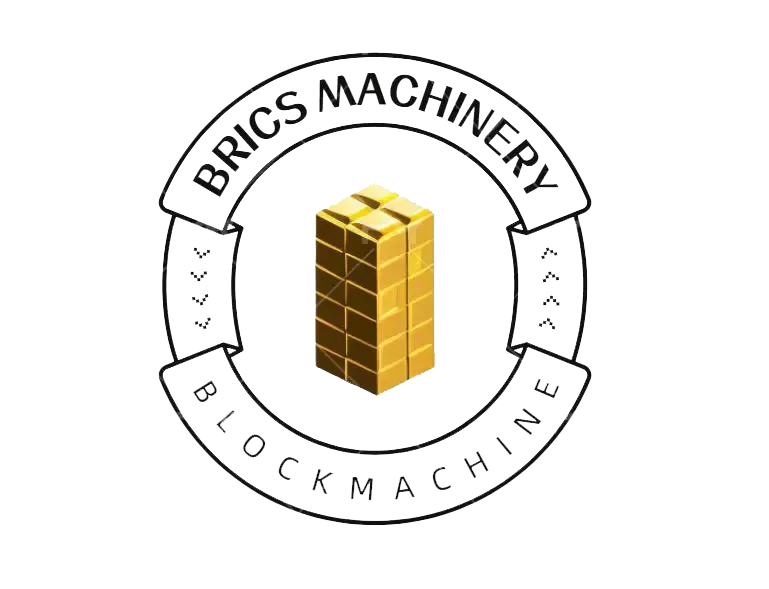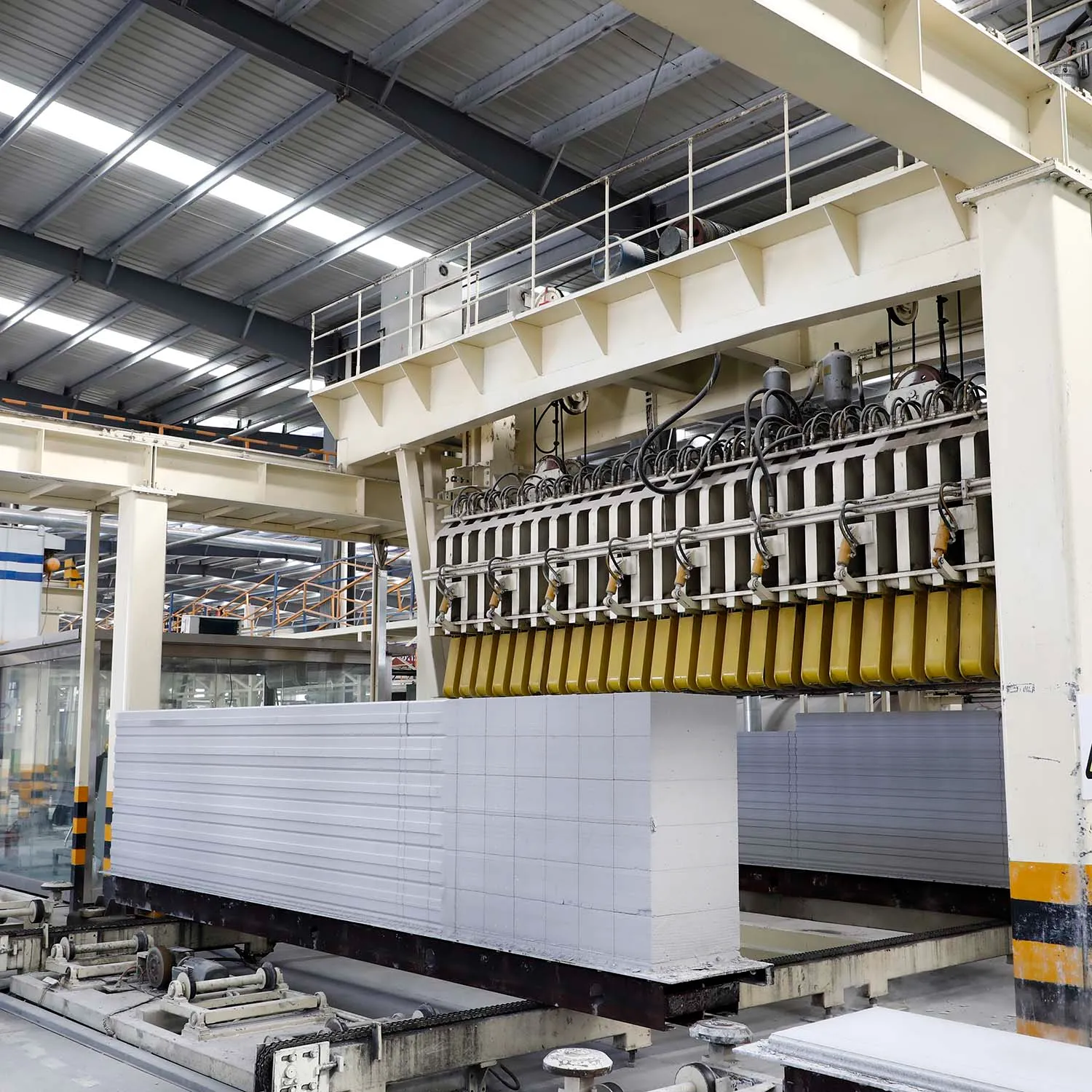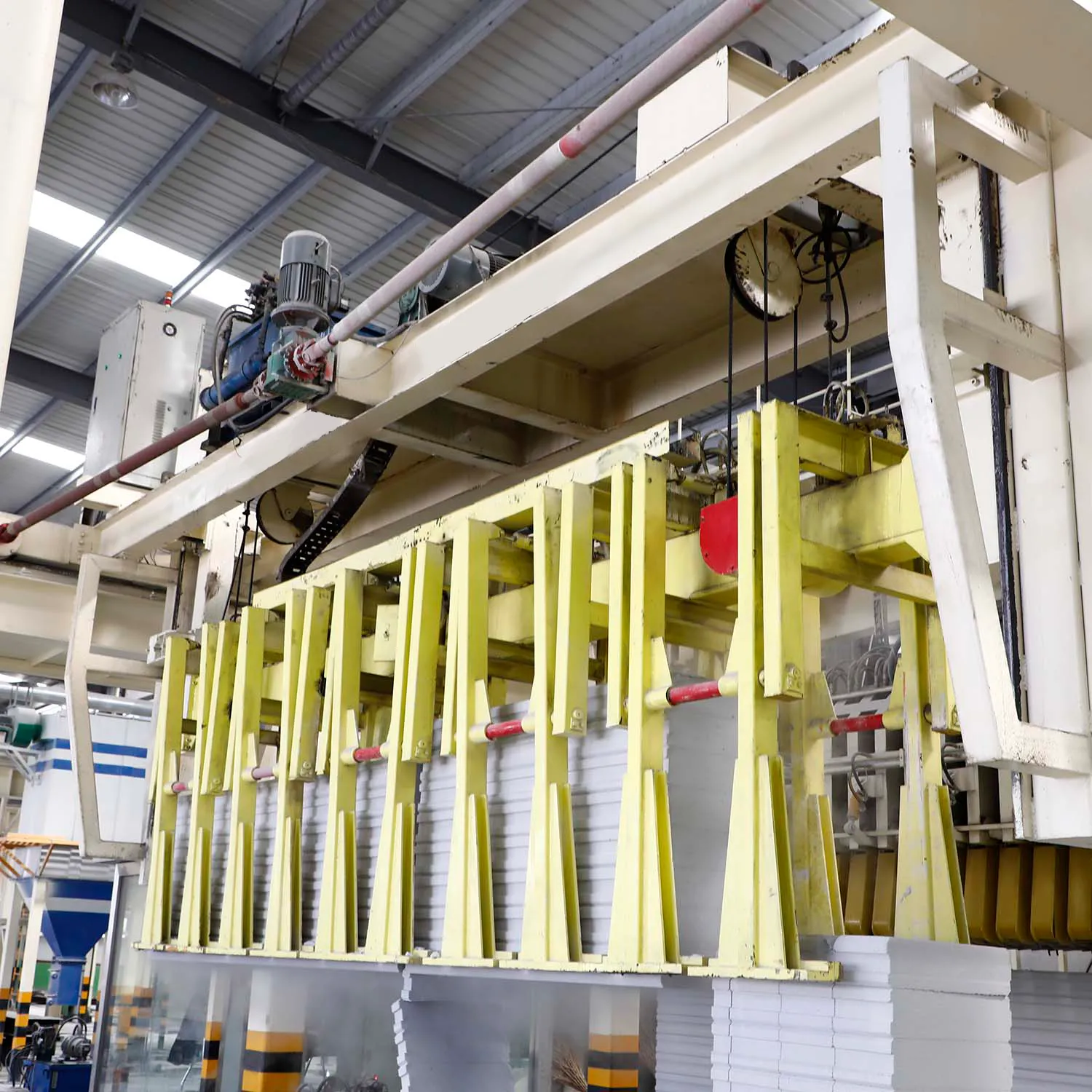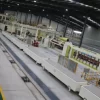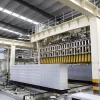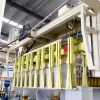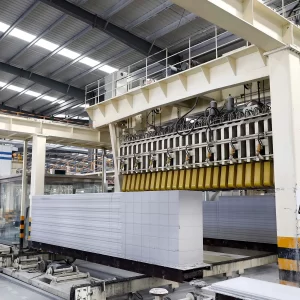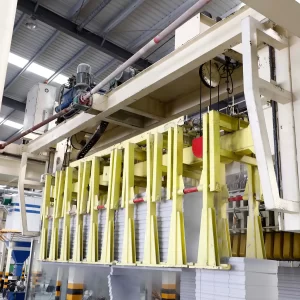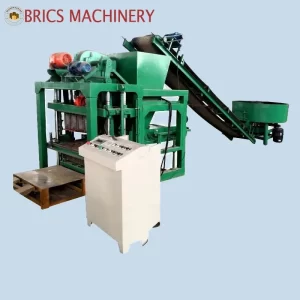SAND AAC BLOCK PLANT
Description
RAW MATERIAL PROCESSING
The process of finely grinding quicklime, cement, gypsum, and sand (aggregate) to achieve a specific surface area of 4000 cm²/g or higher has several benefits. It encourages greater participation of the active ingredients in the chemical reactions, leading to increased strength in autoclaved aerated blocks. Additionally, the deep grinding process results in a thicker slurry when mixing the raw materials with water, which, in turn, enhances the stability of the pouring process.
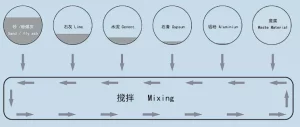
PLC AUTOMATIC BATCHING SYSTEM
The automated batching control system for AAC (Autoclaved Aerated Concrete) block manufacturing offers several advantages, including user-friendly operation, a straightforward interface, high-level intelligence, dependable and stable performance, as well as a simplified system setup.
AAC blocks primarily consist of ingredients such as lime, cement, gypsum, aluminum powder, and sand. Lime and cement act as binding agents, gypsum serves as a hardening agent, and aluminum powder acts as an aerating agent. The entire process is managed by a microcomputer control system, ensuring precise proportions of these components. Here’s a detailed breakdown of the process:
- The microcomputer control system calculates the required proportions of ingredients.
- The mixing tank is opened, and after a predetermined duration, it automatically discharges the slurry.
- When the slurry discharge is completed, an empty signal is generated, and the transport reamer is activated.
- Simultaneously, the system initiates the stirring of aluminum powder.
- After a specific period, the system checks whether the temperature within the mixing tank meets the required criteria.
- If the temperature conditions are met, the system automatically feeds lime and cement into the mixture.
- Once the lime and cement feeding process is finished, an empty signal is again generated.
- After a specific time interval, the transport reamer stops its operation.
- Subsequently, after another predetermined time period, the system automatically starts the stirring process for aluminum powder and simultaneously dispenses aluminum powder into the mixture.
- After yet another interval, the mixer ceases its operation.
- The pouring of the prepared mixture begins and continues until the end of the production process.
- Following the completion of this production cycle, the system awaits the next work order.
Importantly, the system ensures that the feeding of materials from the silos or slurry tanks to the metering tank and the actual feeding into the mixing process are interlocked. This means that one process must complete before the other can begin, preventing any simultaneous feeding processes for safety and quality control purposes.
POURING PROCESS
The production process incorporates fixed casting, with the mold positioned beneath the pouring mixer. Once the pouring is complete, the product is automatically transferred to a curing room equipped with humidity and temperature control mechanisms, which expedite the hardening of the cake.
In contrast to traditional cutting machines that utilize vibration cutting devices, which can be complex to operate and result in significant cutting errors, Dongyue Technology’s Research and Development Center has developed an innovative cutting unit. This new cutting technology draws inspiration from Germany’s WEHRHAHN technology and employs high-quality domestic and international components for the main reducer and control systems, ensuring product stability.
One notable feature of this new cutting unit is the use of a cylinder-tightened, frame-swing mechanism for cross-cutting steel wire, which enhances the durability of the steel wire and improves product precision. A standout advantage is the mobility of the cutting platform, where both the cake and cross-cutting operations take place in the same position. As the cake moves to the next location, both longitudinal and horizontal cutting procedures can be executed seamlessly.
This advanced chain cutting machine offers a high degree of automation, simplifying the operation and significantly reducing the cutting cycle. It allows for a single pass of the steel wire through the cake, resulting in precise cutting dimensions. This innovation effectively shortens the existing production cycle and enhances labor productivity.
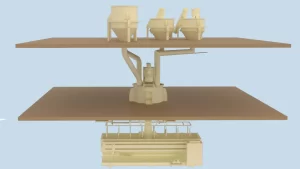
CUTTING SYSTEM
The AAC block cutting machine plays a crucial role in the AAC production line and serves as the central component of the AAC block production plant. It has consistently been the primary focus of research and enhancement efforts at Dongyue Technology Center.
This process is integrated with our company’s pouring mixer, which consists of two key components: the mixing drum and the pouring arm. The pouring arm is designed with a telescopic structure, which serves to minimize the formation of bubbles during the casting process. The mixing drum is cylindrical in shape and comprises a motor, a stirring shaft, and a set of stirring blades. The discharge at the pouring mouth is regulated by a pneumatic butterfly valve. This precise control mechanism ensures the stability of the casting process, leading to enhanced output of AAC blocks, consistent product quality, and an effective reduction in the cost of finished products.
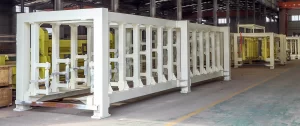
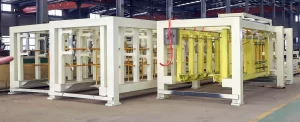

AUTOCLAVE CURING SYSTEM
The proper selection of an autoclave in this process is crucial, as it not only impacts the performance of the products but also influences production efficiency and energy consumption levels.
Within this process, our company employs a pouring mixer, which consists of two integral components: the mixing drum and the pouring arm. The casting arm is designed with a telescopic structure to minimize the formation of bubbles during the casting process. The stirring cylinder is cylindrical and is comprised of a motor, a stirring shaft, and a set of stirring blades. Additionally, the discharge at the pouring mouth is regulated by a pneumatic butterfly valve. This meticulous control mechanism ensures the stability of the casting process and can even lead to an enhanced output of AAC blocks. This, in turn, results in consistent product quality and an effective reduction in the cost of finished products.
The benefits of this system include:
- Straightforward Mechanical Design for Easy Operation:The equipment features a simple mechanical structure, ensuring easy operation and user-friendly handling.
- Flexible Hydraulic System Design:The separator’s hydraulic system is meticulously designed, with individual controls assigned to each pair of clamps. This design allows for the arbitrary selection of clamping and separating positions, enhancing the system’s adaptability and efficiency.
- Adjustable Clamping Force for Varied Block Strengths:The system offers the flexibility to adjust the clamping force of the clamping clamp according to the strength levels of different blocks. Once the desired clamping force is set, the system automatically halts the pressure, ensuring that the clamping force is consistently maintained. This adaptability is crucial for handling blocks with varying strength requirements.
Related projects
LANZHOU TIANKE 300000 M3/A AERATED PLATE BLOCK PROJECT
A 300,000 cubic meters per annum (M3/A) Aerated Board Block Engineering project refers to an industrial operation designed to produce aerated concrete blocks or panels with an annual production capacity of 300,000 cubic meters. Here’s an introduction to such a project:
- Aerated Concrete: Aerated concrete, also known as autoclaved aerated concrete (AAC), is a lightweight precast concrete material made from sand, cement, lime, and aluminum powder. The inclusion of aluminum powder creates small air bubbles in the concrete, making it lightweight, insulating, and suitable for construction.
- Project Scale: This project is intended to produce a substantial amount of aerated concrete products, with a specific annual production capacity of 300,000 cubic meters. This signifies a significant manufacturing operation.
- Production Process: The production process typically involves the mixing of raw materials, pouring the mixture into molds, curing it in autoclaves, and then cutting it into the desired dimensions. The reaction between aluminum powder and calcium hydroxide generates hydrogen gas, which forms air bubbles in the mixture, giving the concrete its lightweight properties.
- Machinery and Equipment: To achieve this production capacity, the project would require a range of machinery and equipment, such as mixers, molds, cutting equipment, curing autoclaves, handling systems, and quality control devices.
- Quality Control: Quality control is crucial to ensure the final products meet the required standards. This involves monitoring the consistency of the mix, curing conditions, and the compressive strength of the finished blocks.
- Market Applications: Aerated concrete blocks are commonly used for wall construction in residential, commercial, and industrial buildings. Their excellent insulation properties and lightweight nature make them a preferred choice for many construction projects.
- Environmental Benefits: Aerated concrete is known for its environmental friendliness. It uses fewer raw materials and less energy in its production compared to traditional concrete. Additionally, it contributes to energy efficiency in buildings due to its insulating properties.
- Economic Impact: A project of this scale can have a significant economic impact by creating jobs and supplying construction materials to the market.
- Regulatory Compliance: It is important to ensure that the project complies with local and national regulations and standards related to construction materials, environmental impact, safety, and quality control.
- Infrastructure Requirements: The project would require access to a reliable supply of raw materials, utilities, and an efficient transportation system for both the incoming raw materials and the outgoing finished products.
- Business Plan: A comprehensive business plan is essential to secure financing, manage resources, and ensure the long-term success and sustainability of the project.
In summary, a 300,000 cubic meters per annum Aerated Board Block Engineering project represents a significant undertaking in the construction industry, focused on the large-scale production of aerated concrete blocks or panels. It requires a well-structured production process, adherence to quality standards and regulations, consideration of environmental and economic impacts, and careful planning to ensure its success.

